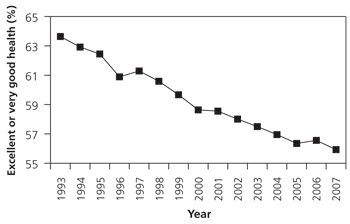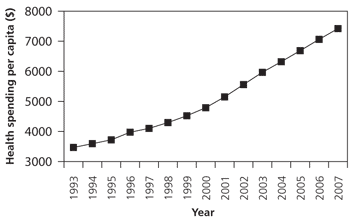
Am Fam Physician. 2009;80(5):427
Despite steady increases in U.S. health care spending, the population's self-perceived health status has been in a long-term decline. Increased support for public health, prevention, and primary care could reduce growth in spending and improve actual and perceived health.
Self-perceived health status is a subjective measure of personal health that correlates with having a chronic disease or risk factors for bad health, and with morbidity and early mortality risk. From 1993 to 2007, the proportion of adults younger than 65 years reporting excellent or very good health steadily declined from 64 to 56 percent (Figure 1).1 During this time, the U.S. population aged and the proportion of minorities (i.e., blacks and Hispanics) increased. Controlling for these two trends does not explain the decline in health status. Also during this time, health spending per capita more than doubled, increasing from $3,468 to $7,421 (Figure 2).2 Despite this rise in spending, U.S. population health fell even further behind the performance of most other developed nations.


Continuing to spend more on our fragmented health care system is unlikely to change the pattern of high expenditures and suboptimal health. Countries that invest in comprehensive primary care systems have better health outcomes, patient satisfaction, and uptake of preventive services, and lower mortality.3 Most spend less per capita than the United States and still achieve superior outcomes.3,4 Focusing on other health determinants (e.g., education, poverty reduction) and reorganizing health spending around public health, prevention, and primary care are likely to improve health at a lower societal cost.